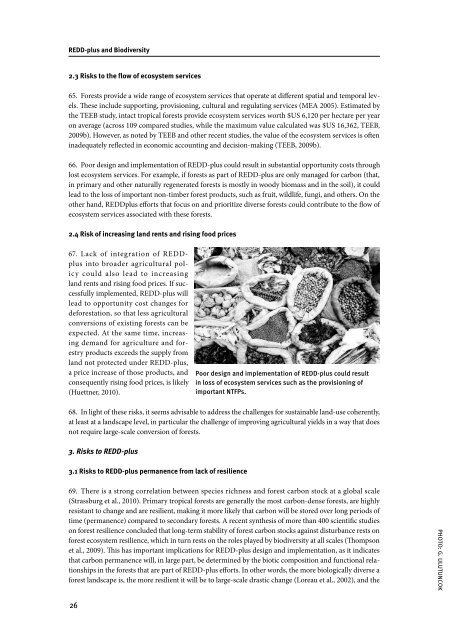REDD-plus and Biodiversity - Convention on Biological Diversity
REDD-plus and Biodiversity - Convention on Biological Diversity
REDD-plus and Biodiversity - Convention on Biological Diversity
You also want an ePaper? Increase the reach of your titles
YUMPU automatically turns print PDFs into web optimized ePapers that Google loves.
<str<strong>on</strong>g>REDD</str<strong>on</strong>g>-<str<strong>on</strong>g>plus</str<strong>on</strong>g> <str<strong>on</strong>g>and</str<strong>on</strong>g> <str<strong>on</strong>g>Biodiversity</str<strong>on</strong>g><br />
2.3 Risks to the flow of ecosystem services<br />
65. Forests provide a wide range of ecosystem services that operate at different spatial <str<strong>on</strong>g>and</str<strong>on</strong>g> temporal levels.<br />
These include supporting, provisi<strong>on</strong>ing, cultural <str<strong>on</strong>g>and</str<strong>on</strong>g> regulating services (MEA 2005). Estimated by<br />
the TEEB study, intact tropical forests provide ecosystem services worth $US 6,120 per hectare per year<br />
<strong>on</strong> average (across 109 compared studies, while the maximum value calculated was $US 16,362, TEEB,<br />
2009b). However, as noted by TEEB <str<strong>on</strong>g>and</str<strong>on</strong>g> other recent studies, the value of the ecosystem services is often<br />
inadequately reflected in ec<strong>on</strong>omic accounting <str<strong>on</strong>g>and</str<strong>on</strong>g> decisi<strong>on</strong>-making (TEEB, 2009b).<br />
66. Poor design <str<strong>on</strong>g>and</str<strong>on</strong>g> implementati<strong>on</strong> of <str<strong>on</strong>g>REDD</str<strong>on</strong>g>-<str<strong>on</strong>g>plus</str<strong>on</strong>g> could result in substantial opportunity costs through<br />
lost ecosystem services. For example, if forests as part of <str<strong>on</strong>g>REDD</str<strong>on</strong>g>-<str<strong>on</strong>g>plus</str<strong>on</strong>g> are <strong>on</strong>ly managed for carb<strong>on</strong> (that,<br />
in primary <str<strong>on</strong>g>and</str<strong>on</strong>g> other naturally regenerated forests is mostly in woody biomass <str<strong>on</strong>g>and</str<strong>on</strong>g> in the soil), it could<br />
lead to the loss of important n<strong>on</strong>-timber forest products, such as fruit, wildlife, fungi, <str<strong>on</strong>g>and</str<strong>on</strong>g> others. On the<br />
other h<str<strong>on</strong>g>and</str<strong>on</strong>g>, <str<strong>on</strong>g>REDD</str<strong>on</strong>g><str<strong>on</strong>g>plus</str<strong>on</strong>g> efforts that focus <strong>on</strong> <str<strong>on</strong>g>and</str<strong>on</strong>g> prioritize diverse forests could c<strong>on</strong>tribute to the flow of<br />
ecosystem services associated with these forests.<br />
2.4 Risk of increasing l<str<strong>on</strong>g>and</str<strong>on</strong>g> rents <str<strong>on</strong>g>and</str<strong>on</strong>g> rising food prices<br />
67. Lack of integrati<strong>on</strong> of <str<strong>on</strong>g>REDD</str<strong>on</strong>g><str<strong>on</strong>g>plus</str<strong>on</strong>g><br />
into broader agricultural policy<br />
could also lead to increasing<br />
l<str<strong>on</strong>g>and</str<strong>on</strong>g> rents <str<strong>on</strong>g>and</str<strong>on</strong>g> rising food prices. If successfully<br />
implemented, <str<strong>on</strong>g>REDD</str<strong>on</strong>g>-<str<strong>on</strong>g>plus</str<strong>on</strong>g> will<br />
lead to opportunity cost changes for<br />
deforestati<strong>on</strong>, so that less agricultural<br />
c<strong>on</strong>versi<strong>on</strong>s of existing forests can be<br />
expected. At the same time, increasing<br />
dem<str<strong>on</strong>g>and</str<strong>on</strong>g> for agriculture <str<strong>on</strong>g>and</str<strong>on</strong>g> forestry<br />
products exceeds the supply from<br />
l<str<strong>on</strong>g>and</str<strong>on</strong>g> not protected under <str<strong>on</strong>g>REDD</str<strong>on</strong>g>-<str<strong>on</strong>g>plus</str<strong>on</strong>g>,<br />
a price increase of those products, <str<strong>on</strong>g>and</str<strong>on</strong>g><br />
c<strong>on</strong>sequently rising food prices, is likely<br />
(Huettner, 2010).<br />
Poor design <str<strong>on</strong>g>and</str<strong>on</strong>g> implementati<strong>on</strong> of <str<strong>on</strong>g>REDD</str<strong>on</strong>g>-<str<strong>on</strong>g>plus</str<strong>on</strong>g> could result<br />
in loss of ecosystem services such as the provisi<strong>on</strong>ing of<br />
important NTFPs.<br />
68. In light of these risks, it seems advisable to address the challenges for sustainable l<str<strong>on</strong>g>and</str<strong>on</strong>g>-use coherently,<br />
at least at a l<str<strong>on</strong>g>and</str<strong>on</strong>g>scape level, in particular the challenge of improving agricultural yields in a way that does<br />
not require large-scale c<strong>on</strong>versi<strong>on</strong> of forests.<br />
3. Risks to <str<strong>on</strong>g>REDD</str<strong>on</strong>g>-<str<strong>on</strong>g>plus</str<strong>on</strong>g><br />
3.1 Risks to <str<strong>on</strong>g>REDD</str<strong>on</strong>g>-<str<strong>on</strong>g>plus</str<strong>on</strong>g> permanence from lack of resilience<br />
69. There is a str<strong>on</strong>g correlati<strong>on</strong> between species richness <str<strong>on</strong>g>and</str<strong>on</strong>g> forest carb<strong>on</strong> stock at a global scale<br />
(Strassburg et al., 2010). Primary tropical forests are generally the most carb<strong>on</strong>-dense forests, are highly<br />
resistant to change <str<strong>on</strong>g>and</str<strong>on</strong>g> are resilient, making it more likely that carb<strong>on</strong> will be stored over l<strong>on</strong>g periods of<br />
time (permanence) compared to sec<strong>on</strong>dary forests. A recent synthesis of more than 400 scientific studies<br />
<strong>on</strong> forest resilience c<strong>on</strong>cluded that l<strong>on</strong>g-term stability of forest carb<strong>on</strong> stocks against disturbance rests <strong>on</strong><br />
forest ecosystem resilience, which in turn rests <strong>on</strong> the roles played by biodiversity at all scales (Thomps<strong>on</strong><br />
et al., 2009). This has important implicati<strong>on</strong>s for <str<strong>on</strong>g>REDD</str<strong>on</strong>g>-<str<strong>on</strong>g>plus</str<strong>on</strong>g> design <str<strong>on</strong>g>and</str<strong>on</strong>g> implementati<strong>on</strong>, as it indicates<br />
that carb<strong>on</strong> permanence will, in large part, be determined by the biotic compositi<strong>on</strong> <str<strong>on</strong>g>and</str<strong>on</strong>g> functi<strong>on</strong>al relati<strong>on</strong>ships<br />
in the forests that are part of <str<strong>on</strong>g>REDD</str<strong>on</strong>g>-<str<strong>on</strong>g>plus</str<strong>on</strong>g> efforts. In other words, the more biologically diverse a<br />
forest l<str<strong>on</strong>g>and</str<strong>on</strong>g>scape is, the more resilient it will be to large-scale drastic change (Loreau et al., 2002), <str<strong>on</strong>g>and</str<strong>on</strong>g> the<br />
PHOTO: G. Ulutuncok<br />
26

















